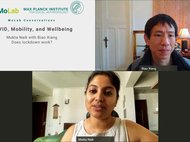Securitizing Mobilities
The securitization of mobilities is the effort to make mobilities safe for the state, the public and for the migrants themselves, though one party’s safety is often another party’s hazard. Specific measures include contact tracing; logistical intervention; contactless delivery; and traveller screening and qualification. These measures do not necessarily reduce mobilities, and a key goal of the securitization is to ensure continuous circulations of goods, capital and people as a basis of the economy.
Text Entries | Conversations in video or audio
These programmes aim to enable mobility—instead of hindering movement—that is legal, orderly, facilitated by reliable networks, and pursued by informed migrants. Like the securitization of mobility, safe migration means different things to different actors. — Sverre Molland, Biao Xiang
The securitization of mobility is, by definition, a myriad of operational processes instead of a single policy. It is carried out in multiple ways, and at different times of movements. — Sverre Molland, Biao Xiang
he COVID-19 pandemic set back some progressive measures offered to migrant workers in the Mekong Delta; for instance, the relatively open access to medical care available regardless of legal status, and the region-wide coordination to improve migration regulation and migrant protection. During the pandemic, some migrants were left uncontrolled and uncared for. — Sverre Molland, Biao Xiang
In liberal democracies, mobility control normally targets foreigners. Noncitizens beyond the border need special permission to enter, while citizens inside are free to move or leave. The securitization of mobility changes this. — Sverre Molland, Biao Xiang
In this video, Sverre Molland (Senior Lecturer in Anthropology, Australian National University) and Biao Xiang discuss how the securitization of mobility differs from the classical means of mobility control, namely with border closure and lockdown. — Sverre Molland, Biao Xiang
If individual mobilities were securitized—e.g. through tracing, monitoring and vaccine certification—borders could remain open during pandemics. There could be a trade-off between personal privacy and personal freedom of movement. But would such a substitution be feasible, or desirable? — Jelena Dzankic, Timothy Jacob-Owens, Lorenzo Piccoli, Biao Xiang
India imposed a national lockdown at the early stage of the pandemic in March 2020, but opted for local containment in 2021 when the situation was much worse. What explain the policy choices? How have the measures affected residents, especially migrants, differently? — Mukta Naik, Biao Xiang







